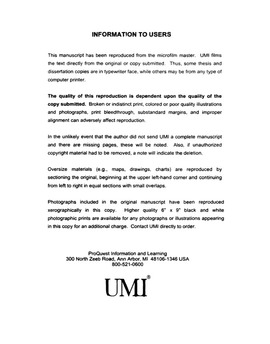| dc.contributor.advisor | Genova, Pamela, | en_US |
| dc.contributor.advisor | Busby, Keith, | en_US |
| dc.contributor.author | Ouellette, Edward G. | en_US |
| dc.date.accessioned | 2013-08-16T12:18:17Z | |
| dc.date.available | 2013-08-16T12:18:17Z | |
| dc.date.issued | 2001 | en_US |
| dc.identifier.uri | https://hdl.handle.net/11244/328 | |
| dc.description.abstract | Chapter 4. "The Parables." The parables are an important aspect of the story of Barlaam et Josaphaz, and many enjoyed a popularity outside the story of these two saints. In this chapter I examine Chardri's decision to leave them out of his version, and their treatment at both the hands of Gui de Cambrai and the anonymous author. | en_US |
| dc.description.abstract | Chapter 6. "Conclusion." In this chapter I review my findings and show how they confirm my original hypothesis that the story of Barlaam et Josaphaz can be classified under more than one genre. | en_US |
| dc.description.abstract | Chapter 5. "The Additions and Amplifications in the version of Gui de Cambrai." Of the three versions of Barlaam et Josaphaz in verse, that of Gui de Cambrai deserves especial consideration, in that it takes the most liberties with its source material and was selected by a later scribe as a vehicle for attacking the very class of people, the aristocracy, for whom it was commissioned. In this chapter I examine these liberties, showing how they confirm that Gui was indeed writing for a courtly audience. | en_US |
| dc.description.abstract | Chapter 2. "The Redactors." In this chapter I examine each of the three redactors who translated this story into the vernacular, their choice of style, and their possible motivations for doing so. | en_US |
| dc.description.abstract | Barlaam et Josaphaz is a saint's life that enjoyed much popularity in the middle ages. Accepted as a Christianized retelling of the Buddha story, it was translated from Greek (originally accepted as being written by John Damascene, the consensus now is that it was composed by Euthymius. See Wolf: "Barlaam and Iosaph, " Harvard Theological Review XXXII, 1939.) into Latin and thence into most of the languages of Western Europe (see Pflaum: Der Reliogionsdisput der Barlaam-Legende, ein Motiv Abendlandischer Dichtung pp. 224--52 for a complete listing). This Latin source served as the basis for three metrical versions in Old French, written by an anonymous translator, Gui de Cambrai and an Anglo-Norman called Chardri. Written at roughly the same time, between 1180 and 1225 CE, there is no indication that these authors knew each other's work. The Version Anonyme and that of Gui de Cambrai come from the continent, while that of Chardri is from England. Significantly, while all three used the same Latin vita as their source, they each created a unique version of the story. My dissertation studies each verse version in relation to the source vita, the other verse versions, salient themes, and their language/vocabulary in an attempt to ascertain whether the story truly falls under Hagiography, or should be more properly considered a Romance or Epic Romance. | en_US |
| dc.description.abstract | Chapter 3. "The Texts." This chapter focuses on the texts themselves and on which genre each could, or should, be classified under. | en_US |
| dc.description.abstract | Chapter 1. "A Question of Genre." In this chapter I explore the definition of genre and how modern scholars apply it to medieval literary works. Additionally, I introduce my contention that the story of Barlaam et Josaphaz can be classified under more than one genre. | en_US |
| dc.format.extent | vii, 151 leaves ; | en_US |
| dc.subject | Barlaam and Joasaph. | en_US |
| dc.subject | Literature, Medieval. | en_US |
| dc.subject | Literature, Medieval History and criticism. | en_US |
| dc.subject | Literature, Romance. | en_US |
| dc.title | A comparative study of the three French versions in verse of the story of "Barlaam et Josaphaz". | en_US |
| dc.type | Thesis | en_US |
| dc.thesis.degree | Ph.D. | en_US |
| dc.thesis.degreeDiscipline | Department of Modern Languages, Literatures, and Linguistics | en_US |
| dc.note | Major Professors: Keith Busby; Pamela Genova. | en_US |
| dc.note | Source: Dissertation Abstracts International, Volume: 62-04, Section: A, page: 1403. | en_US |
| ou.identifier | (UMI)AAI3013152 | en_US |
| ou.group | College of Arts and Sciences::Department of Modern Languages, Literatures, and Linguistics | |
